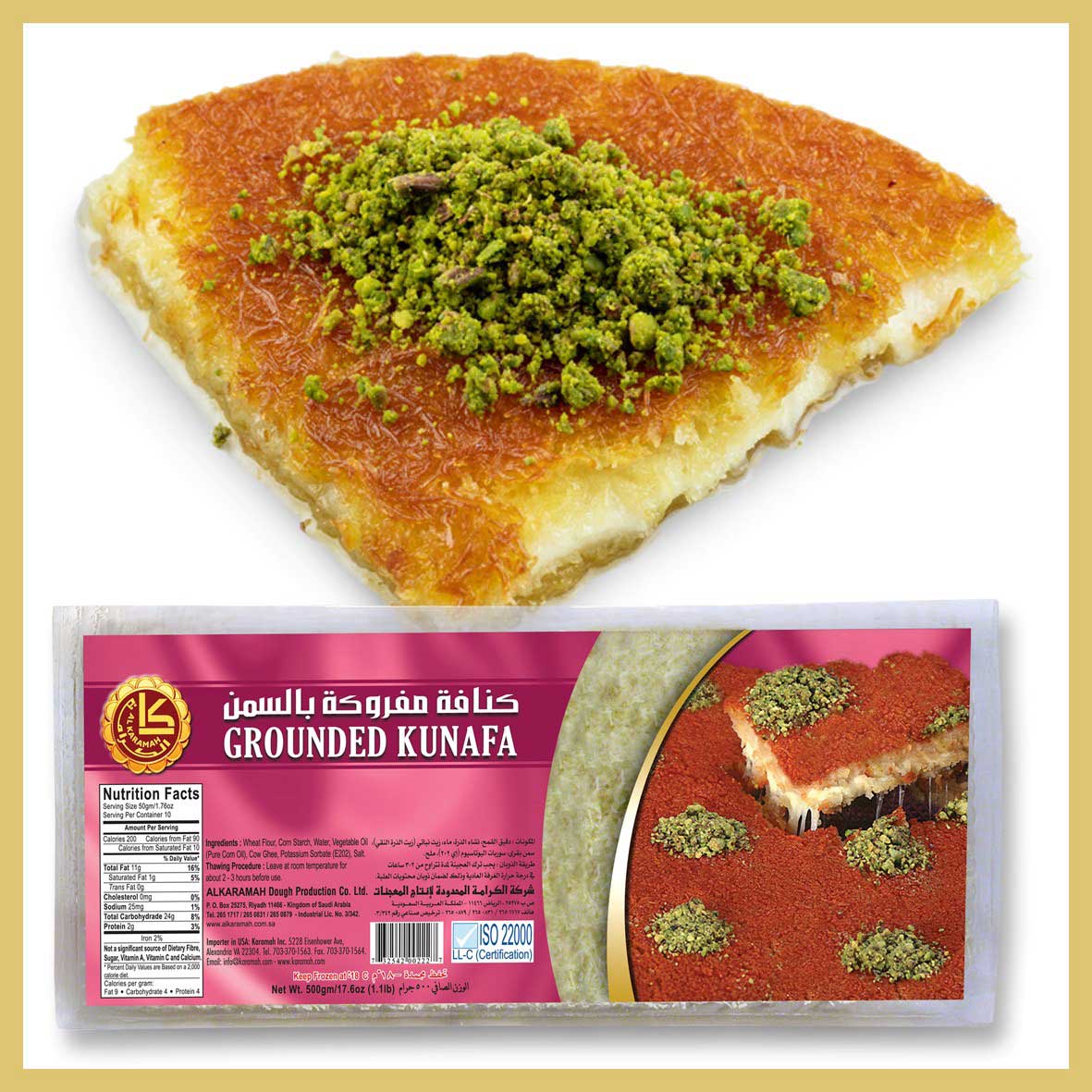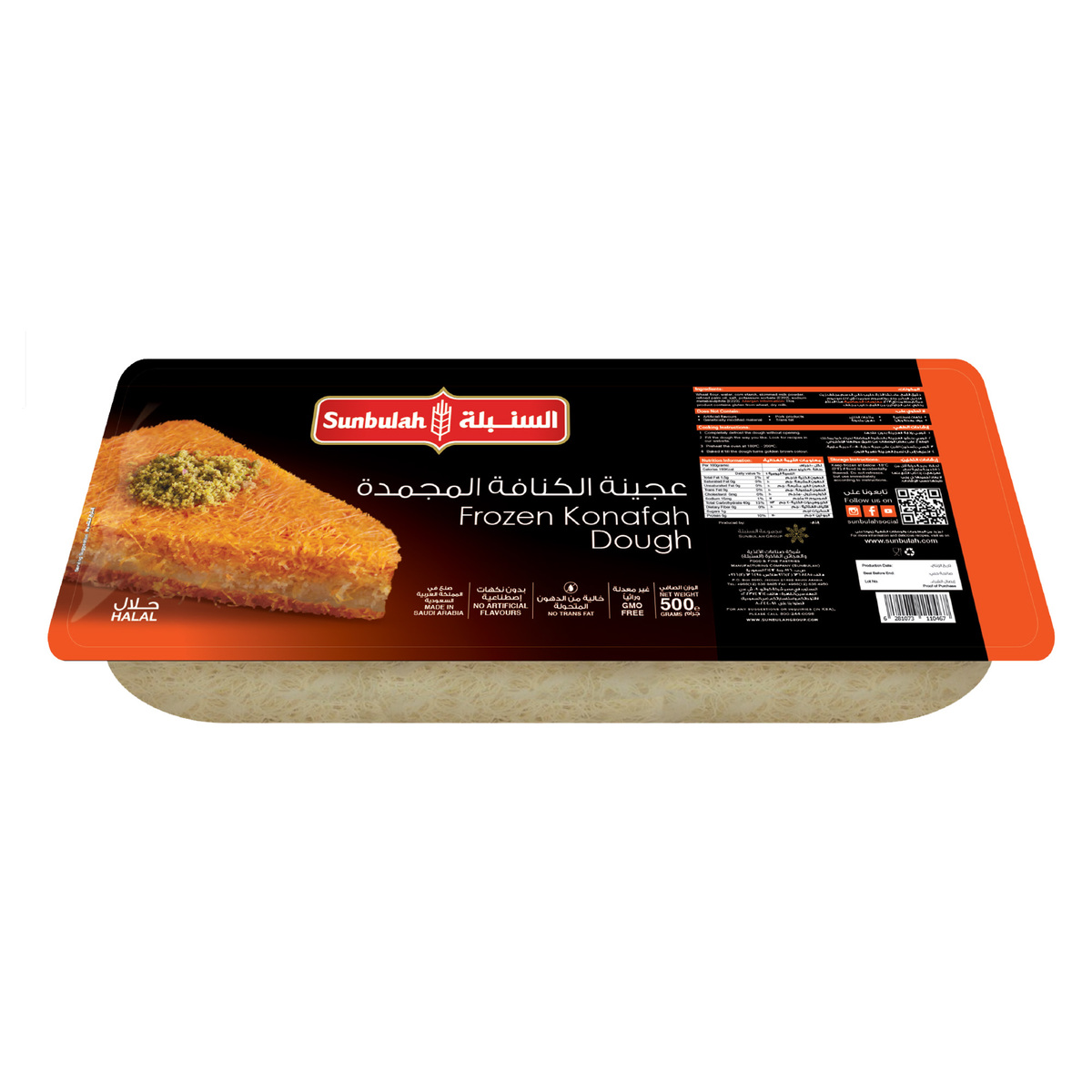Frozen Knafeh Dough: A Comprehensive Guide To The Delightful Middle Eastern Treat
So listen up, folks. If you're into Middle Eastern desserts, you’ve probably heard of knafeh. But what about frozen knafeh dough? Yeah, that’s right—this magical frozen treat is taking the culinary world by storm. Imagine biting into something that’s both sweet and savory, with a texture that’s just out of this world. It's like having a piece of heaven in your mouth. Now, let’s dive into the world of frozen knafeh dough and uncover all its secrets.
This frozen knafeh dough is more than just a dessert; it’s a cultural phenomenon that’s been around for centuries. Originating from the Middle East, it’s become a staple in many households and bakeries. The best part? You can now enjoy it without the hassle of making it from scratch. How cool is that? So, whether you're a knafeh enthusiast or just someone looking to try something new, this guide is for you.
Now, let’s be real. Not everyone has the time or patience to make knafeh from scratch. That’s where frozen knafeh dough comes in. It’s convenient, easy to use, and still delivers that authentic taste we all love. So, if you’re ready to learn more about this delightful dessert, stick around because we’re about to take you on a journey through its history, preparation, and everything in between.
Read also:Unveiling The Mysteries Of Sone 436 Plot A Comprehensive Guide
What Exactly is Frozen Knafeh Dough?
Frozen knafeh dough is essentially the pre-prepared version of the traditional knafeh pastry. This dough is made using a combination of semolina, flour, and butter, giving it that signature crispy texture. Once prepared, it’s frozen to preserve its freshness and flavor. This makes it incredibly convenient for those who want to enjoy knafeh without the hassle of making the dough themselves.
The Benefits of Using Frozen Knafeh Dough
Using frozen knafeh dough has its perks. Here are some of the top benefits:
- Convenience: No need to spend hours in the kitchen preparing the dough.
- Consistency: You get the same great taste and texture every time.
- Time-Saving: Perfect for busy individuals who still want to enjoy homemade desserts.
- Cost-Effective: Often cheaper than buying ready-to-eat knafeh from a bakery.
So, if you’re someone who values convenience without compromising on taste, frozen knafeh dough is definitely worth considering.
History of Knafeh and Its Evolution
Knafeh has a rich history that dates back centuries. It’s believed to have originated in the city of Nablus in Palestine, where it quickly became a popular dessert across the Middle East. Traditionally, knafeh was made using fresh cheese, sugar syrup, and a layer of knafeh dough on top. Over time, the recipe evolved, and now we have variations like frozen knafeh dough, which makes it easier for people to enjoy this delicious treat.
The evolution of knafeh reflects the changing lifestyles of people. As life got busier, the demand for convenient food options increased. This is where frozen knafeh dough stepped in, offering a solution that didn’t compromise on taste or quality. Today, you can find frozen knafeh dough in supermarkets and specialty stores, making it accessible to a wider audience.
Where to Buy Frozen Knafeh Dough
Finding frozen knafeh dough has never been easier. You can usually find it in:
Read also:Unveiling The Feathered Mystery Was Dilophosaurus Cloaked In Feathers
- Local Middle Eastern Markets: These stores often carry a variety of frozen knafeh dough options.
- Supermarkets: Many large supermarket chains now stock frozen knafeh dough in their international food sections.
- Online Retailers: Websites like Amazon and specialty food sites offer a wide selection of frozen knafeh dough.
When buying frozen knafeh dough, make sure to check the expiration date and storage instructions to ensure you’re getting a quality product.
How to Prepare Frozen Knafeh Dough
Preparing frozen knafeh dough is a breeze. Here’s a step-by-step guide to help you get started:
- Defrost the Dough: Take the dough out of the freezer and let it thaw at room temperature for about 30 minutes.
- Preheat Your Oven: Set your oven to 350°F (175°C) to ensure it’s ready when you are.
- Assemble the Knafeh: Place a layer of dough in a greased baking pan, add your favorite filling (like cheese or nuts), and cover with another layer of dough.
- Bake: Pop it in the oven for about 25-30 minutes or until golden brown.
- Add Syrup: Once baked, drizzle some sugar syrup over the top for that authentic knafeh flavor.
And there you have it—a delicious knafeh made with frozen dough that’s sure to impress your friends and family.
Tips for Perfect Knafeh
Here are a few tips to ensure your knafeh turns out perfectly every time:
- Don’t overbake the dough; it should be golden brown, not dark.
- Use high-quality ingredients for the best flavor.
- Experiment with different fillings to find your favorite combination.
- Let the knafeh sit for a few minutes after baking to allow the syrup to soak in.
These tips will help you achieve that perfect balance of flavors and textures that make knafeh so irresistible.
Popular Variations of Knafeh
While traditional knafeh is made with cheese, there are plenty of variations to try. Here are some popular ones:
- Nabulsi Cheese Knafeh: The classic version using soft, salty cheese.
- Akkawi Cheese Knafeh: A milder cheese option that’s great for those who prefer less salt.
- Nut Knafeh: Filled with pistachios, walnuts, or almonds for a nutty twist.
- Custard Knafeh: A creamy filling that adds a unique twist to the traditional recipe.
These variations offer something for everyone, whether you’re a fan of savory or sweet desserts.
Healthier Alternatives
For those looking to enjoy knafeh without the guilt, there are healthier alternatives available:
- Reduced Sugar Syrup: Opt for syrups with less sugar or use natural sweeteners like honey.
- Whole Grain Dough: Some brands offer frozen knafeh dough made with whole grains for added nutrition.
- Low-Fat Cheese: Use low-fat cheese options to cut down on calories.
These alternatives allow you to enjoy the deliciousness of knafeh while keeping your health goals in mind.
Where Does Frozen Knafeh Dough Fit in Modern Cuisine?
In today’s fast-paced world, convenience is key. Frozen knafeh dough fits perfectly into this modern lifestyle, offering a quick and easy way to enjoy a traditional dessert. It’s not just about saving time; it’s about maintaining the authenticity of the dish while making it more accessible to a global audience.
Chefs and home cooks alike are embracing frozen knafeh dough as a way to innovate traditional recipes. By combining it with modern techniques and ingredients, they’re creating new and exciting dishes that pay homage to the original while adding their own twist.
Global Influence
The popularity of frozen knafeh dough isn’t limited to the Middle East. It’s gaining traction worldwide, with people from all cultures discovering and loving this delicious treat. This global influence is helping to spread the rich culinary heritage of the Middle East to new audiences.
As more people try frozen knafeh dough, they’re incorporating it into their own cuisines, creating a fusion of flavors that’s both unique and exciting.
Common Questions About Frozen Knafeh Dough
Here are some frequently asked questions about frozen knafeh dough:
Is Frozen Knafeh Dough as Good as Fresh?
Absolutely! While fresh knafeh dough has its charm, frozen dough is just as good when prepared correctly. The key is to follow the instructions carefully and use high-quality ingredients.
Can I Freeze My Own Knafeh Dough?
Yes, you can! If you have leftover dough, simply wrap it tightly in plastic wrap and place it in the freezer. It will keep for several months, ready to use whenever you’re in the mood for knafeh.
How Long Does Frozen Knafeh Dough Last?
Frozen knafeh dough typically lasts for up to six months in the freezer. Always check the expiration date and storage instructions on the packaging to ensure freshness.
Conclusion
So there you have it, folks. Frozen knafeh dough is a game-changer in the world of Middle Eastern desserts. It’s convenient, delicious, and offers a taste of tradition with a modern twist. Whether you’re a knafeh enthusiast or just someone looking to try something new, this frozen treat is definitely worth exploring.
Now, here’s your call to action. Go out there, try frozen knafeh dough, and let us know what you think. Leave a comment below sharing your experience or any tips you have. And don’t forget to share this article with your friends and family so they can enjoy this delightful dessert too. Until next time, happy baking!
Table of Contents
- What Exactly is Frozen Knafeh Dough?
- The Benefits of Using Frozen Knafeh Dough
- History of Knafeh and Its Evolution
- Where to Buy Frozen Knafeh Dough
- How to Prepare Frozen Knafeh Dough
- Tips for Perfect Knafeh
- Popular Variations of Knafeh
- Healthier Alternatives
- Where Does Frozen Knafeh Dough Fit in Modern Cuisine?
- Common Questions About Frozen Knafeh Dough


